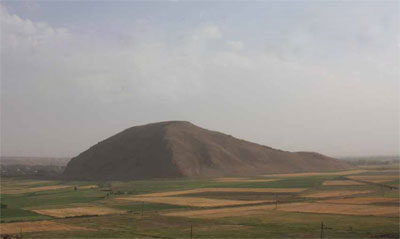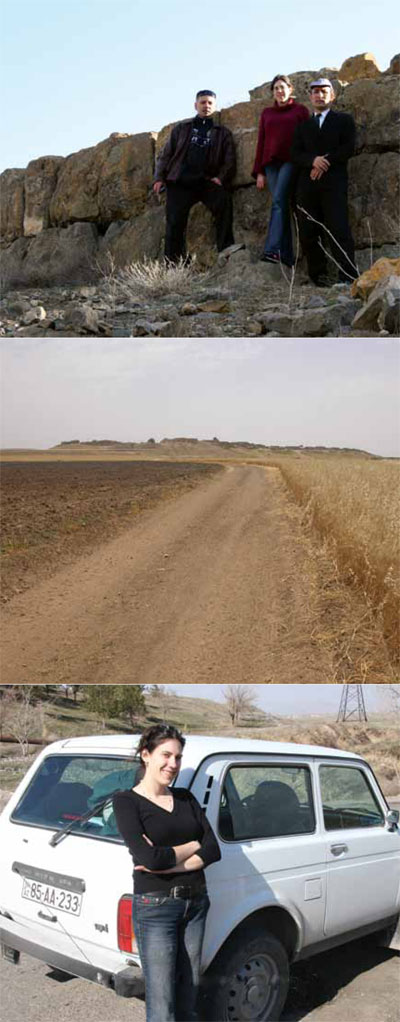
Lauren Ristvet, the Robert H. Dyson, Jr. Assistant Curator in the Museum’s Near East Section, became interested in archaeology while growing up in New Mexico. She and her brother, Matthew, explored the Southwestern archaeological landscape while hiking.
Ristvet’s early interests led her to pursue an anthropology degree at Yale University from 1996 to 1999. Her interest in Near Eastern archaeology, however, resulted from taking classes taught by Harvey Weiss (Ph.D. ’76, University of Pennsylvania). In 1999, Ristvet went to Syria with Weiss’ Tell Leilan Project, where she participated in excavations and enjoyed the hospitality of the local villagers. She entered the M.A. program at Cambridge University in 1999. Her M.A. thesis combined information from cuneiform tablets and archaeological data, including renewed excavations at the site of Chagar Bazar in northern Syria. Following this, Ristvet worked as a research assistant in the Near East/Mediterranean sections at the Peabody Museum at Yale University from 2000 to 2001, before returning to the Ph.D. program at Cambridge in 2001. During this time, Ristvet continued to work in Syria, analyzing data from the Tell Leilan Survey for her doctoral dissertation, which she completed in 2005. This survey provided a wealth of data and insight into the processes of state formation, Akkadian period imperialism and collapse, and political regeneration during the early 2nd millennium BCE.

Middle, Tell Leilan, Syria, from the west. At 90 hectares, Tell Leilan is one of the largest sites in Syria, and served as the capital of Shamshi- Adad’s Kingdom of Northern Mesopotamia around 1800 BCE.
Bottom, Lauren Ristvet on survey in the Naxçıvan Autonomous Republic, Azerbaijan. Naxçivan, which is located north of Iran and east of Turkey, is physically separated from the rest of Azerbaijan.
After completing her Ph.D., Ristvet taught at Georgia State University from 2005 to 2008. In 2008, she was hired by the University of Pennsylvania as an Assistant Professor in Anthropology and an Assistant Curator in the Penn Museum. She is continuing her research in Syria with the Tell Leilan Project and has a forthcoming book (with Andrew McCarthy) about their excavations of the city gate area, which dates from the 3rd to the 2nd millennium BCE.
In addition to her research in Syria, Ristvet recently has begun long-term investigations in Azerbaijan, where she is one of the first Westerners to begin a project (the Naxçivan Archaeological Project) in this archaeologically under-explored area. In partnership with Safar As ̧urov and Veli Baxs ̧aliyev at the National Academy of Sciences of Azerbaijan, she initiated the first intensive survey of Naxçivan, Azerbaijan in 2006. Soundings at some of the survey sites focused on collecting samples for radiocarbon dating in order to establish a chronology for the spread of the Early Transcaucasian culture, material of which, dating to the early 3rd millennium BCE, was found from the Caucausus to Israel. This work seeks to improve our understanding of the political and social linkages in the greater Middle East during the 3rd millennium BCE.
In 2008, Ristvet received funding from the National Science Foundation for three field seasons at the large fortress site of Oğlanqala (“Knights Castle”) in Naxçivan, Azerbaijan. Considered a border or frontier area during the Iron Age (1200–300 BCE), the site controls a large fertile plain, an important mountain pass, and lies along a major route from Lake Urmia (Iran) to Lake Sevan (Armenia). Ristvet’s first season (2008) focused on mapping and opening excavations in the ancient palace and a residential area. These excavations revealed unusual sandstone columns, probably dating from the Achaemenid period (550–330 BCE), which suggest that the site was a regional capital. A small sounding in earlier Iron Age levels found several sherds of large storage jars with cuneiform inscriptions, the oldest evidence of writing ever found in excavations in Azerbaijan.
Future seasons will include excavations at the palace as well as in private houses. One of Ristvet’s goals is to document how incorporation into the Persian Empire affected the daily lives of the people of Oğlanqala, by focusing on changes in production and consumption as shown through pottery, ancient seeds, and animal bones. A 3D GIS map of the excavation will show where all the findings originated and their relationship to the architecture. Eventually, Ristvet will excavate materials from the underlying earlier Iron Age occupations, some of which are contemporary with Hasanlu in Iran (excavated by Penn Museum Director Emeritus Robert Dyson). Ristvet’s research at Oğlanqala will lead to a better understanding of imperialism, particularly the interactions between imperial powers and local inhabitants.
